#tepelene
Text
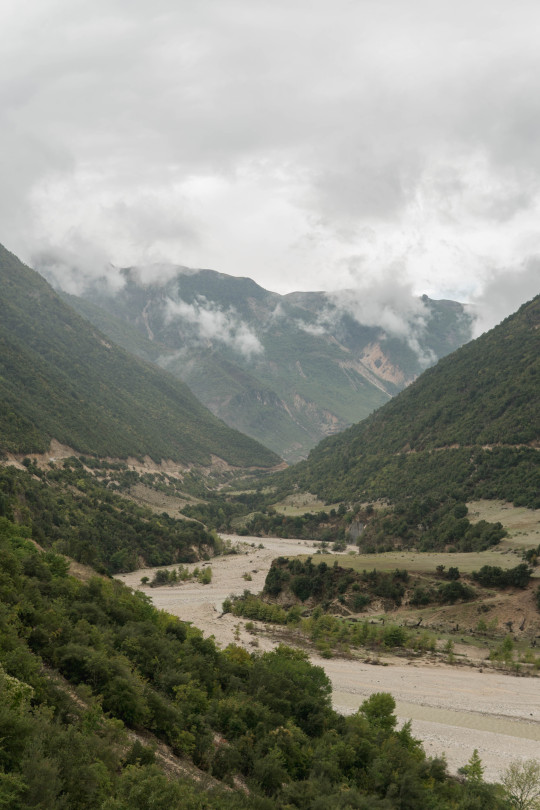
23 notes
·
View notes
Text

Vaj ulliri ekstra i virgjer ne shitje me shumice ose pakice dergesa me poste . Na kontaktoni ne numrin e telefonit +355695870548
https://produktebio.net/
#vajulliri#vajullirineshitje#vajullirineshitjeshqiperi#Tirane#Shkoder#Fier#Elbasan#Vlore#Sarande#Pogradec#Kruje#Tepelene
0 notes
Text
Makina del nga rruga në Levan - Tepelenë, plagoset shoferia.
Fier – Nje mjet tip ford qe drejtohej nga nje vajze rreth te 30 ka humbur kontrollin dhe per pasoje ka dale jashte rruge ka ndodhur paraditen e sotme. Ne vendgjarje kane mberritur policia dhe autoambulanca qe kane shoqeruar per ne spitalin e Fierit.
Aksidenti ka ndodhur ne autostradën Levan – Tepelene ne Kafaraj
Makina ka dal nga rrugaShoferia eshte dërguar ne spital ku ka marr ndihmen…

View On WordPress
0 notes
Photo
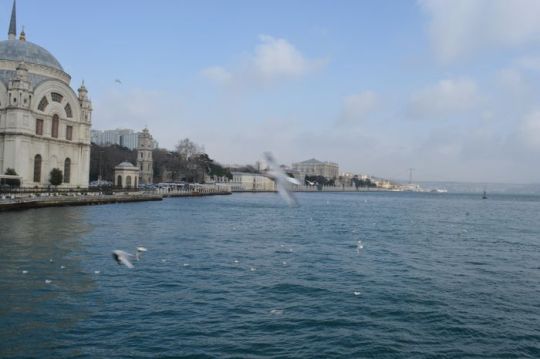
Our Lady of the Fishes
The buildings seen just outside Yedi Kuleh gate are the hospitals, lunatic asylum, and orphan schools, belonging to the Greek and Armenian communities of Constantinople; and the Greek Shrine of Our Lady of the Fishes.
The first outer tower passed on the way from Yedi Kuleh to Silivri Kapusu (Silivri Gate) bears an ancient inscription. The closed gate which comes next is probably the old Bhegion Gate; and the next but two, farther on, which was partly destroyed by the earthquake of 1894, and of which only the two sides bearing an inscription and a cross are now left standing, was built by John Pakeologus in 1433. On the ninth inner tower are carved the names of the Emperors Leo and Constantine. The. tenth and eleventh outer towers are assigned to John Palaeologus, who reigned from 1433 to 1444. The inscription seen on the city side of the tower on the right when entering Silivri Gate sets forth that the gate was called the Spring Gatey from the processions of pilgrims which usually passed through it on their way to the monastery of Our Lady of the Fishes.
Ali Pasha Tepelen
Ibrahim Pasha’s Mosque, just within the gate, is supposed to have once been St. Anne’s Church. In the cemetery attached to the mosque may be seen some three or four tombstones on the graves of women, unique from being artistically carved on both sides. Silivri Gate is the one by which Alexius Strategopoulo, the general of Michael Palaeologus, entered by stratagem on the night of the 6th of August 1261, with 800 men, and took the city from the Latins. The three graves seen at the end of the cemetery opposite the gate contain the decapitated heads of the celebrated Ali Pasha Tepelen mentioned in Byron’s poems, and of his two sons, Yely and Muktar.
The third outer tower beyond Silivri Kapu was, according to the inscription on it, built by John Palseologus in 1439.
Ymi Kapu (New Gate), which comes next, is the third public gate from the Marmora, and is also called Mevlehaneh Kapusu, from the convent of Mevlevi or Dancing Dervishes in the street opposite it. These dervishes perform on Thursdays just after mid-day. Yen! Kapu is the Melandesias Gate of the Byzantines, which led to the village of Melantiade, now Buyuk Checkmedjeh. Of the two Greek inscriptions, that seen on one side of the gate sets forth that Cyrus, prefect of the city, erected wall within wall for the beloved sovereign (Theodosius II.) in sixty days. The inscription on the other side of the gate is to the effect that the breastwork was restored in the reign of Justin and Sophia (566-578) by Narses, the most glorious
Spatharius, architect to that emperor. The Latin inscription also seen on the gate is merely a Latin rendering of the first of the two Greek inscriptions, and runs thus : Theodosii jussis gemino nec mense peracto Constantinus ovans hcec mania firma locavit. Tam cito tarn stabilem Pallas vix conderet arcem ( By order of Theodosius, Constantine triumphantly erected this stronghold in less than two months. Pallas herself could scarcely build so strong a fortress in so short a time’).
1 note
·
View note
Photo

Our Lady of the Fishes
The buildings seen just outside Yedi Kuleh gate are the hospitals, lunatic asylum, and orphan schools, belonging to the Greek and Armenian communities of Constantinople; and the Greek Shrine of Our Lady of the Fishes.
The first outer tower passed on the way from Yedi Kuleh to Silivri Kapusu (Silivri Gate) bears an ancient inscription. The closed gate which comes next is probably the old Bhegion Gate; and the next but two, farther on, which was partly destroyed by the earthquake of 1894, and of which only the two sides bearing an inscription and a cross are now left standing, was built by John Pakeologus in 1433. On the ninth inner tower are carved the names of the Emperors Leo and Constantine. The. tenth and eleventh outer towers are assigned to John Palaeologus, who reigned from 1433 to 1444. The inscription seen on the city side of the tower on the right when entering Silivri Gate sets forth that the gate was called the Spring Gatey from the processions of pilgrims which usually passed through it on their way to the monastery of Our Lady of the Fishes.
Ali Pasha Tepelen
Ibrahim Pasha’s Mosque, just within the gate, is supposed to have once been St. Anne’s Church. In the cemetery attached to the mosque may be seen some three or four tombstones on the graves of women, unique from being artistically carved on both sides. Silivri Gate is the one by which Alexius Strategopoulo, the general of Michael Palaeologus, entered by stratagem on the night of the 6th of August 1261, with 800 men, and took the city from the Latins. The three graves seen at the end of the cemetery opposite the gate contain the decapitated heads of the celebrated Ali Pasha Tepelen mentioned in Byron’s poems, and of his two sons, Yely and Muktar.
The third outer tower beyond Silivri Kapu was, according to the inscription on it, built by John Palseologus in 1439.
Ymi Kapu (New Gate), which comes next, is the third public gate from the Marmora, and is also called Mevlehaneh Kapusu, from the convent of Mevlevi or Dancing Dervishes in the street opposite it. These dervishes perform on Thursdays just after mid-day. Yen! Kapu is the Melandesias Gate of the Byzantines, which led to the village of Melantiade, now Buyuk Checkmedjeh. Of the two Greek inscriptions, that seen on one side of the gate sets forth that Cyrus, prefect of the city, erected wall within wall for the beloved sovereign (Theodosius II.) in sixty days. The inscription on the other side of the gate is to the effect that the breastwork was restored in the reign of Justin and Sophia (566-578) by Narses, the most glorious
Spatharius, architect to that emperor. The Latin inscription also seen on the gate is merely a Latin rendering of the first of the two Greek inscriptions, and runs thus : Theodosii jussis gemino nec mense peracto Constantinus ovans hcec mania firma locavit. Tam cito tarn stabilem Pallas vix conderet arcem ( By order of Theodosius, Constantine triumphantly erected this stronghold in less than two months. Pallas herself could scarcely build so strong a fortress in so short a time’).
0 notes
Photo

Our Lady of the Fishes
The buildings seen just outside Yedi Kuleh gate are the hospitals, lunatic asylum, and orphan schools, belonging to the Greek and Armenian communities of Constantinople; and the Greek Shrine of Our Lady of the Fishes.
The first outer tower passed on the way from Yedi Kuleh to Silivri Kapusu (Silivri Gate) bears an ancient inscription. The closed gate which comes next is probably the old Bhegion Gate; and the next but two, farther on, which was partly destroyed by the earthquake of 1894, and of which only the two sides bearing an inscription and a cross are now left standing, was built by John Pakeologus in 1433. On the ninth inner tower are carved the names of the Emperors Leo and Constantine. The. tenth and eleventh outer towers are assigned to John Palaeologus, who reigned from 1433 to 1444. The inscription seen on the city side of the tower on the right when entering Silivri Gate sets forth that the gate was called the Spring Gatey from the processions of pilgrims which usually passed through it on their way to the monastery of Our Lady of the Fishes.
Ali Pasha Tepelen
Ibrahim Pasha’s Mosque, just within the gate, is supposed to have once been St. Anne’s Church. In the cemetery attached to the mosque may be seen some three or four tombstones on the graves of women, unique from being artistically carved on both sides. Silivri Gate is the one by which Alexius Strategopoulo, the general of Michael Palaeologus, entered by stratagem on the night of the 6th of August 1261, with 800 men, and took the city from the Latins. The three graves seen at the end of the cemetery opposite the gate contain the decapitated heads of the celebrated Ali Pasha Tepelen mentioned in Byron’s poems, and of his two sons, Yely and Muktar.
The third outer tower beyond Silivri Kapu was, according to the inscription on it, built by John Palseologus in 1439.
Ymi Kapu (New Gate), which comes next, is the third public gate from the Marmora, and is also called Mevlehaneh Kapusu, from the convent of Mevlevi or Dancing Dervishes in the street opposite it. These dervishes perform on Thursdays just after mid-day. Yen! Kapu is the Melandesias Gate of the Byzantines, which led to the village of Melantiade, now Buyuk Checkmedjeh. Of the two Greek inscriptions, that seen on one side of the gate sets forth that Cyrus, prefect of the city, erected wall within wall for the beloved sovereign (Theodosius II.) in sixty days. The inscription on the other side of the gate is to the effect that the breastwork was restored in the reign of Justin and Sophia (566-578) by Narses, the most glorious
Spatharius, architect to that emperor. The Latin inscription also seen on the gate is merely a Latin rendering of the first of the two Greek inscriptions, and runs thus : Theodosii jussis gemino nec mense peracto Constantinus ovans hcec mania firma locavit. Tam cito tarn stabilem Pallas vix conderet arcem ( By order of Theodosius, Constantine triumphantly erected this stronghold in less than two months. Pallas herself could scarcely build so strong a fortress in so short a time’).
0 notes
Text
New Post has been published on Lalka
Our Lady of the Fishes
The buildings seen just outside Yedi Kuleh gate are the hospitals, lunatic asylum, and orphan schools, belonging to the Greek and Armenian communities of Constantinople; and the Greek Shrine of Our Lady of the Fishes.
The first outer tower passed on the way from Yedi Kuleh to Silivri Kapusu (Silivri Gate) bears an ancient inscription. The closed gate which comes next is probably the old Bhegion Gate; and the next but two, farther on, which was partly destroyed by the earthquake of 1894, and of which only the two sides bearing an inscription and a cross are now left standing, was built by John Pakeologus in 1433. On the ninth inner tower are carved the names of the Emperors Leo and Constantine. The. tenth and eleventh outer towers are assigned to John Palaeologus, who reigned from 1433 to 1444. The inscription seen on the city side of the tower on the right when entering Silivri Gate sets forth that the gate was called the Spring Gatey from the processions of pilgrims which usually passed through it on their way to the monastery of Our Lady of the Fishes.
Ali Pasha Tepelen
Ibrahim Pasha’s Mosque, just within the gate, is supposed to have once been St. Anne’s Church. In the cemetery attached to the mosque may be seen some three or four tombstones on the graves of women, unique from being artistically carved on both sides. Silivri Gate is the one by which Alexius Strategopoulo, the general of Michael Palaeologus, entered by stratagem on the night of the 6th of August 1261, with 800 men, and took the city from the Latins. The three graves seen at the end of the cemetery opposite the gate contain the decapitated heads of the celebrated Ali Pasha Tepelen mentioned in Byron’s poems, and of his two sons, Yely and Muktar.
The third outer tower beyond Silivri Kapu was, according to the inscription on it, built by John Palseologus in 1439.
Ymi Kapu (New Gate), which comes next, is the third public gate from the Marmora, and is also called Mevlehaneh Kapusu, from the convent of Mevlevi or Dancing Dervishes in the street opposite it. These dervishes perform on Thursdays just after mid-day. Yen! Kapu is the Melandesias Gate of the Byzantines, which led to the village of Melantiade, now Buyuk Checkmedjeh. Of the two Greek inscriptions, that seen on one side of the gate sets forth that Cyrus, prefect of the city, erected wall within wall for the beloved sovereign (Theodosius II.) in sixty days. The inscription on the other side of the gate is to the effect that the breastwork was restored in the reign of Justin and Sophia (566-578) by Narses, the most glorious
Spatharius, architect to that emperor. The Latin inscription also seen on the gate is merely a Latin rendering of the first of the two Greek inscriptions, and runs thus : Theodosii jussis gemino nec mense peracto Constantinus ovans hcec mania firma locavit. Tam cito tarn stabilem Pallas vix conderet arcem ( By order of Theodosius, Constantine triumphantly erected this stronghold in less than two months. Pallas herself could scarcely build so strong a fortress in so short a time’).
0 notes
Photo
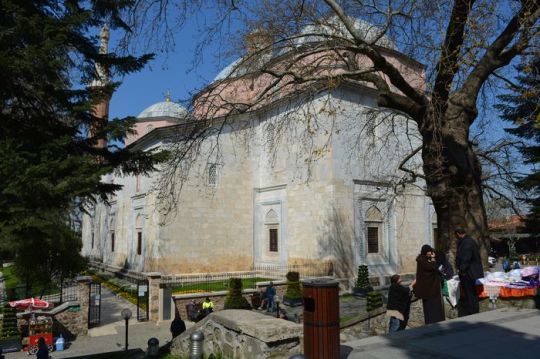
Our Lady of the Fishes
The buildings seen just outside Yedi Kuleh gate are the hospitals, lunatic asylum, and orphan schools, belonging to the Greek and Armenian communities of Constantinople; and the Greek Shrine of Our Lady of the Fishes.
The first outer tower passed on the way from Yedi Kuleh to Silivri Kapusu (Silivri Gate) bears an ancient inscription. The closed gate which comes next is probably the old Bhegion Gate; and the next but two, farther on, which was partly destroyed by the earthquake of 1894, and of which only the two sides bearing an inscription and a cross are now left standing, was built by John Pakeologus in 1433. On the ninth inner tower are carved the names of the Emperors Leo and Constantine. The. tenth and eleventh outer towers are assigned to John Palaeologus, who reigned from 1433 to 1444. The inscription seen on the city side of the tower on the right when entering Silivri Gate sets forth that the gate was called the Spring Gatey from the processions of pilgrims which usually passed through it on their way to the monastery of Our Lady of the Fishes.
Ali Pasha Tepelen
Ibrahim Pasha’s Mosque, just within the gate, is supposed to have once been St. Anne’s Church. In the cemetery attached to the mosque may be seen some three or four tombstones on the graves of women, unique from being artistically carved on both sides. Silivri Gate is the one by which Alexius Strategopoulo, the general of Michael Palaeologus, entered by stratagem on the night of the 6th of August 1261, with 800 men, and took the city from the Latins. The three graves seen at the end of the cemetery opposite the gate contain the decapitated heads of the celebrated Ali Pasha Tepelen mentioned in Byron’s poems, and of his two sons, Yely and Muktar.
The third outer tower beyond Silivri Kapu was, according to the inscription on it, built by John Palseologus in 1439.
Ymi Kapu (New Gate), which comes next, is the third public gate from the Marmora, and is also called Mevlehaneh Kapusu, from the convent of Mevlevi or Dancing Dervishes in the street opposite it. These dervishes perform on Thursdays just after mid-day. Yen! Kapu is the Melandesias Gate of the Byzantines, which led to the village of Melantiade, now Buyuk Checkmedjeh. Of the two Greek inscriptions, that seen on one side of the gate sets forth that Cyrus, prefect of the city, erected wall within wall for the beloved sovereign (Theodosius II.) in sixty days. The inscription on the other side of the gate is to the effect that the breastwork was restored in the reign of Justin and Sophia (566-578) by Narses, the most glorious
Spatharius, architect to that emperor. The Latin inscription also seen on the gate is merely a Latin rendering of the first of the two Greek inscriptions, and runs thus : Theodosii jussis gemino nec mense peracto Constantinus ovans hcec mania firma locavit. Tam cito tarn stabilem Pallas vix conderet arcem ( By order of Theodosius, Constantine triumphantly erected this stronghold in less than two months. Pallas herself could scarcely build so strong a fortress in so short a time’).
0 notes
Photo
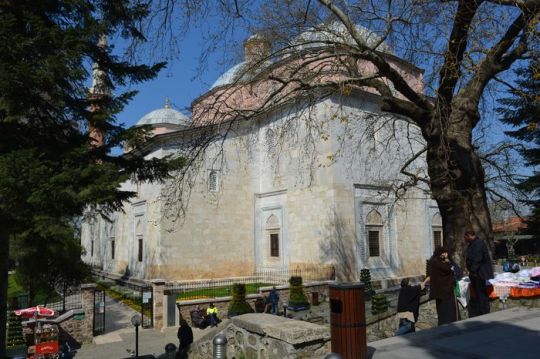
Our Lady of the Fishes
The buildings seen just outside Yedi Kuleh gate are the hospitals, lunatic asylum, and orphan schools, belonging to the Greek and Armenian communities of Constantinople; and the Greek Shrine of Our Lady of the Fishes.
The first outer tower passed on the way from Yedi Kuleh to Silivri Kapusu (Silivri Gate) bears an ancient inscription. The closed gate which comes next is probably the old Bhegion Gate; and the next but two, farther on, which was partly destroyed by the earthquake of 1894, and of which only the two sides bearing an inscription and a cross are now left standing, was built by John Pakeologus in 1433. On the ninth inner tower are carved the names of the Emperors Leo and Constantine. The. tenth and eleventh outer towers are assigned to John Palaeologus, who reigned from 1433 to 1444. The inscription seen on the city side of the tower on the right when entering Silivri Gate sets forth that the gate was called the Spring Gatey from the processions of pilgrims which usually passed through it on their way to the monastery of Our Lady of the Fishes.
Ali Pasha Tepelen
Ibrahim Pasha’s Mosque, just within the gate, is supposed to have once been St. Anne’s Church. In the cemetery attached to the mosque may be seen some three or four tombstones on the graves of women, unique from being artistically carved on both sides. Silivri Gate is the one by which Alexius Strategopoulo, the general of Michael Palaeologus, entered by stratagem on the night of the 6th of August 1261, with 800 men, and took the city from the Latins. The three graves seen at the end of the cemetery opposite the gate contain the decapitated heads of the celebrated Ali Pasha Tepelen mentioned in Byron’s poems, and of his two sons, Yely and Muktar.
The third outer tower beyond Silivri Kapu was, according to the inscription on it, built by John Palseologus in 1439.
Ymi Kapu (New Gate), which comes next, is the third public gate from the Marmora, and is also called Mevlehaneh Kapusu, from the convent of Mevlevi or Dancing Dervishes in the street opposite it. These dervishes perform on Thursdays just after mid-day. Yen! Kapu is the Melandesias Gate of the Byzantines, which led to the village of Melantiade, now Buyuk Checkmedjeh. Of the two Greek inscriptions, that seen on one side of the gate sets forth that Cyrus, prefect of the city, erected wall within wall for the beloved sovereign (Theodosius II.) in sixty days. The inscription on the other side of the gate is to the effect that the breastwork was restored in the reign of Justin and Sophia (566-578) by Narses, the most glorious
Spatharius, architect to that emperor. The Latin inscription also seen on the gate is merely a Latin rendering of the first of the two Greek inscriptions, and runs thus : Theodosii jussis gemino nec mense peracto Constantinus ovans hcec mania firma locavit. Tam cito tarn stabilem Pallas vix conderet arcem ( By order of Theodosius, Constantine triumphantly erected this stronghold in less than two months. Pallas herself could scarcely build so strong a fortress in so short a time’).
0 notes
Photo

Our Lady of the Fishes
The buildings seen just outside Yedi Kuleh gate are the hospitals, lunatic asylum, and orphan schools, belonging to the Greek and Armenian communities of Constantinople; and the Greek Shrine of Our Lady of the Fishes.
The first outer tower passed on the way from Yedi Kuleh to Silivri Kapusu (Silivri Gate) bears an ancient inscription. The closed gate which comes next is probably the old Bhegion Gate; and the next but two, farther on, which was partly destroyed by the earthquake of 1894, and of which only the two sides bearing an inscription and a cross are now left standing, was built by John Pakeologus in 1433. On the ninth inner tower are carved the names of the Emperors Leo and Constantine. The. tenth and eleventh outer towers are assigned to John Palaeologus, who reigned from 1433 to 1444. The inscription seen on the city side of the tower on the right when entering Silivri Gate sets forth that the gate was called the Spring Gatey from the processions of pilgrims which usually passed through it on their way to the monastery of Our Lady of the Fishes.
Ali Pasha Tepelen
Ibrahim Pasha’s Mosque, just within the gate, is supposed to have once been St. Anne’s Church. In the cemetery attached to the mosque may be seen some three or four tombstones on the graves of women, unique from being artistically carved on both sides. Silivri Gate is the one by which Alexius Strategopoulo, the general of Michael Palaeologus, entered by stratagem on the night of the 6th of August 1261, with 800 men, and took the city from the Latins. The three graves seen at the end of the cemetery opposite the gate contain the decapitated heads of the celebrated Ali Pasha Tepelen mentioned in Byron’s poems, and of his two sons, Yely and Muktar.
The third outer tower beyond Silivri Kapu was, according to the inscription on it, built by John Palseologus in 1439.
Ymi Kapu (New Gate), which comes next, is the third public gate from the Marmora, and is also called Mevlehaneh Kapusu, from the convent of Mevlevi or Dancing Dervishes in the street opposite it. These dervishes perform on Thursdays just after mid-day. Yen! Kapu is the Melandesias Gate of the Byzantines, which led to the village of Melantiade, now Buyuk Checkmedjeh. Of the two Greek inscriptions, that seen on one side of the gate sets forth that Cyrus, prefect of the city, erected wall within wall for the beloved sovereign (Theodosius II.) in sixty days. The inscription on the other side of the gate is to the effect that the breastwork was restored in the reign of Justin and Sophia (566-578) by Narses, the most glorious
Spatharius, architect to that emperor. The Latin inscription also seen on the gate is merely a Latin rendering of the first of the two Greek inscriptions, and runs thus : Theodosii jussis gemino nec mense peracto Constantinus ovans hcec mania firma locavit. Tam cito tarn stabilem Pallas vix conderet arcem ( By order of Theodosius, Constantine triumphantly erected this stronghold in less than two months. Pallas herself could scarcely build so strong a fortress in so short a time’).
0 notes
Photo
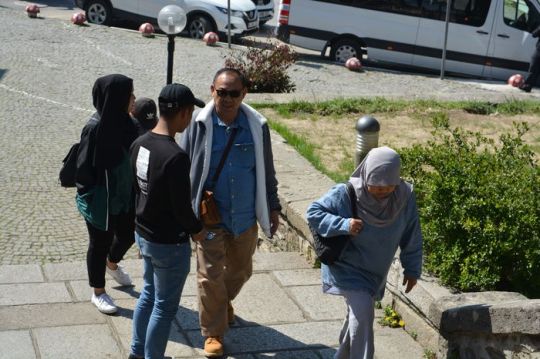
Our Lady of the Fishes
The buildings seen just outside Yedi Kuleh gate are the hospitals, lunatic asylum, and orphan schools, belonging to the Greek and Armenian communities of Constantinople; and the Greek Shrine of Our Lady of the Fishes.
The first outer tower passed on the way from Yedi Kuleh to Silivri Kapusu (Silivri Gate) bears an ancient inscription. The closed gate which comes next is probably the old Bhegion Gate; and the next but two, farther on, which was partly destroyed by the earthquake of 1894, and of which only the two sides bearing an inscription and a cross are now left standing, was built by John Pakeologus in 1433. On the ninth inner tower are carved the names of the Emperors Leo and Constantine. The. tenth and eleventh outer towers are assigned to John Palaeologus, who reigned from 1433 to 1444. The inscription seen on the city side of the tower on the right when entering Silivri Gate sets forth that the gate was called the Spring Gatey from the processions of pilgrims which usually passed through it on their way to the monastery of Our Lady of the Fishes.
Ali Pasha Tepelen
Ibrahim Pasha’s Mosque, just within the gate, is supposed to have once been St. Anne’s Church. In the cemetery attached to the mosque may be seen some three or four tombstones on the graves of women, unique from being artistically carved on both sides. Silivri Gate is the one by which Alexius Strategopoulo, the general of Michael Palaeologus, entered by stratagem on the night of the 6th of August 1261, with 800 men, and took the city from the Latins. The three graves seen at the end of the cemetery opposite the gate contain the decapitated heads of the celebrated Ali Pasha Tepelen mentioned in Byron’s poems, and of his two sons, Yely and Muktar.
The third outer tower beyond Silivri Kapu was, according to the inscription on it, built by John Palseologus in 1439.
Ymi Kapu (New Gate), which comes next, is the third public gate from the Marmora, and is also called Mevlehaneh Kapusu, from the convent of Mevlevi or Dancing Dervishes in the street opposite it. These dervishes perform on Thursdays just after mid-day. Yen! Kapu is the Melandesias Gate of the Byzantines, which led to the village of Melantiade, now Buyuk Checkmedjeh. Of the two Greek inscriptions, that seen on one side of the gate sets forth that Cyrus, prefect of the city, erected wall within wall for the beloved sovereign (Theodosius II.) in sixty days. The inscription on the other side of the gate is to the effect that the breastwork was restored in the reign of Justin and Sophia (566-578) by Narses, the most glorious
Spatharius, architect to that emperor. The Latin inscription also seen on the gate is merely a Latin rendering of the first of the two Greek inscriptions, and runs thus : Theodosii jussis gemino nec mense peracto Constantinus ovans hcec mania firma locavit. Tam cito tarn stabilem Pallas vix conderet arcem ( By order of Theodosius, Constantine triumphantly erected this stronghold in less than two months. Pallas herself could scarcely build so strong a fortress in so short a time’).
0 notes
Photo
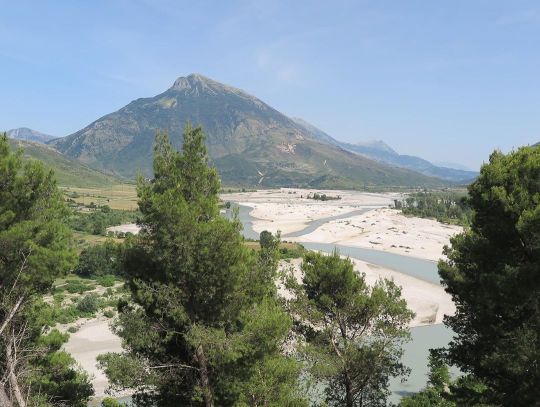
Southern Albania. Photos by: Patrick Müller on Flickr.
(at Tepelenë, Albania)
https://www.instagram.com/p/CAmv-u6phZ6/?igshid=v5whmey3mnp5
#beauty_of_albania#albania#shqiperia#architecture#archilovers#history#europe#ig_europe#traveleurope#travel#tourist#tourism#tepelene#nature#naturephotography#investinalbania#invest#visitalbania#explore#coloursofalbania2019#colorsofalbania
5 notes
·
View notes
Photo

Tepelenë, Albania, 1851.
18 notes
·
View notes
Text

As I said I can't say no to food
10 notes
·
View notes
Text
“Kthesat e Fratarit” në aksin e autostradës Levan – Tepelenë burim aksidentesh.
“Kthesat e Fratarit” në aksin e autostradës Levan – Tepelenë burim aksidentesh.
Mallakastër – Kur kanë kaluar dy vjet nga shkarja e kodrës ku u bllokua autostrada Levan – Tepelenë në vendin quajtur “Kthesat e Fratarit” ende vendi nuk është rehabilituar e të vihet në funksion, por po përdoret rruga provizore që u ndërtua në atë periudhë.
Kjo përbën një rrezikshmëri të lartë për automjetet që lëvizin në drejtim nga Jugu për në Fier pasi nga rruga që ka qën e drejt ka një…

View On WordPress
0 notes
Photo

#Silence of the #lambs. 🤫🐑 #travel #trip #gusmar #tepelene #Albania #visitalbania #explorealbania #guidedtours #tourguide (at Progonat) https://www.instagram.com/p/CcQy0piN1Bl/?igshid=NGJjMDIxMWI=
#silence#lambs#travel#trip#gusmar#tepelene#albania#visitalbania#explorealbania#guidedtours#tourguide
1 note
·
View note